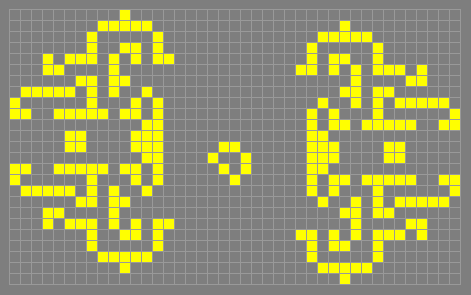An oscillator in which two HW volcanoes hassle a
loaf. This was found by Mark Niemiec in February 1995. A smaller
version using Scot Ellison's reduced HW volcano is shown below.

David I. Bell, Spaceships in Conway's Life.
Series of articles posted on comp.theory.cell-automata,
Aug-Oct 1992. Now available from
his website.
David I. Bell, Speed c/3 Technology in Conway's Life,
17 December 1999. Available from
his website.
Elwyn R. Berlekamp, John H. Conway and Richard K. Guy,
Winning Ways for your Mathematical Plays, II: Games in Particular.
Academic Press, 1982.
David J Buckingham, Some Facts of Life. BYTE, December 1978.
Dave Buckingham, My Experience with B-heptominos in Oscillators.
12 October 1996.
Available
from Paul Callahan's website.
David J. Buckingham and Paul B. Callahan,
Tight Bounds on Periodic Cell Configurations in Life.
Experimental Mathematics 7:3 (1998) 221-241.
Available at
http://tinyurl.com/TightBoundsOnCellConfigs.
Noam D. Elkies, The still-Life density problem and its
generalizations,
pp228-253 of "Voronoi's Impact on Modern Science,
Book I", P. Engel, H. Syta (eds), Institute of Mathematics, Kyiv, 1998
= Vol.21 of Proc. Inst. Math. Nat. Acad. Sci. Ukraine,
math.CO/9905194.
Martin Gardner, Wheels, Life, and other Mathematical Amusements.
W. H. Freeman and Company, 1983.
R. Wm. Gosper, Exploiting Regularities in Large Cellular Spaces.
Physica 10D (1984) 75-80.
N. M. Gotts and P. B. Callahan, Emergent structures in sparse fields of
Conway's 'Game of Life', in Artificial Life VI: Proceedings of the
Sixth International Conference on Artificial Life, MIT Press, 1998.
Mark D Niemiec, Life Algorithms. BYTE, January 1979.
William Poundstone, The Recursive Universe.
William Morrow and Company Inc., 1985.









